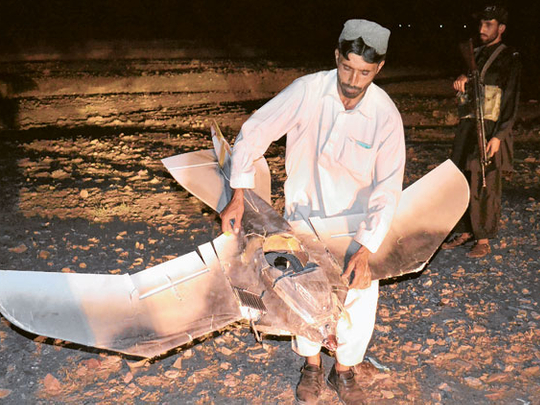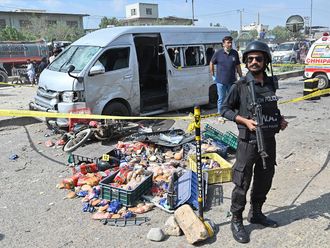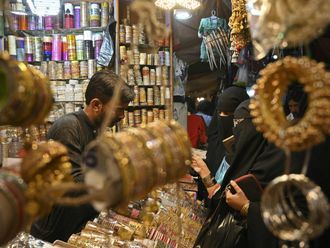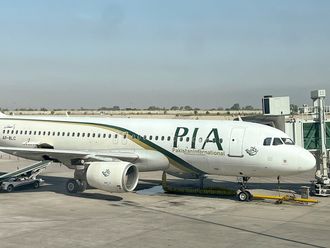
Peshawar: The death squad shows up in uniform: black masks and tunics with the name of the group, Khorasan Mujahideen, scrawled across the back in Urdu.
Pulling up in caravans of Toyota Corolla hatchbacks, dozens of them seal off mud-hut villages near the Afghan border, and then scour markets and homes in search of tribesmen they suspect of helping to identify targets for the armed US drones that routinely buzz overhead.
Once they've snatched their suspect, they don't speed off, villagers say. Instead, the caravan leaves slowly, a trademark gesture meant to convey that they expect no retaliation.
Militant groups lack the ability to bring down the drones, which have killed senior Al Qaida and Taliban commanders as well as many foot soldiers. Instead, a collection of them have banded together to form Khorasan Mujahideen in the North Waziristan tribal region to hunt for those who sell information about the location of militants and their safe houses.
Pakistani officials and tribal elders maintain that most of those who are abducted this way are innocent, but after being beaten, burned with irons or scalded with boiling water, almost all eventually "confess." And few ever come back.
One who did was a shop owner in the town of Mir Ali, a well-known hub of militant activity.
A band of Khorasan gunmen strode up to the shop owner one afternoon last autumn, threw him into one of their cars and drove away, said a relative who spoke on condition of anonymity for fear of reprisal. They took him to a safe house being used as a lockup for others the group suspected of spying for the drone programme.
‘Terrorised'
For the next eight weeks, they bludgeoned him with sticks, trying to get him to confess that he was a drone spy. He wasn't, said the relative. Unable to determine whether he was guilty, his captors released him to another militant group, which set him free ten days later.
"In the sky there are drones, and on the ground there's Khorasan Mujahideen," said the relative. "Villagers are extremely terrorised. Whenever there's a drone strike, within 24 hours Khorasan Mujahideen comes in and takes people away."
Most of them are killed. The group dumps the bodies on the roadside, usually with scraps of paper attached to their bloodied tunics that warn others of the consequences of spying for the US. Executions are often videotaped and distributed to DVD kiosks in Peshawar to hammer home the message.
In one video, an old man with a bruised and swollen face says he was paid $1,300 (Dh4,775) for information that led to a drone strike in a North Waziristan village last year. "I was misguided by the devil," says the man, who identifies himself as Subedar. "Khorasan Mujahideen never pressured me or used force against me. They showed me respect. May God give them victory."
Near the end of the video, he is shown with a bag over his head as a gunman first shoots him to death at point blank range with an AK-47 assault rifle, then pumps more than 30 rounds into his corpse.
Another suspected informant standing alongside a village road with his hands tied behind his back is killed by explosives detonated at his feet. Gunmen fire wildly into the sky to celebrate.
Despite such brutal treatment if they are caught, some people find it hard to resist the payoff of working as an informant for the Americans. North Waziristan, a mountainous, remote tribal area, is racked by poverty and joblessness.
Information about how much informants are paid, who finds and pays them, or how they operate is difficult to obtain, because few people want to risk discussing such matters. But interviews with tribal elders and a former Pakistani intelligence official suggest the pay can range from $300 to $1,000 or more for information that helps pinpoint a target.
"When I spoke to informants, they said they did it for the money," said the former Pakistani intelligence official, who spoke on condition of anonymity. "And most Pashtuns don't like the Taliban. They want the Taliban out because their whole tribal system has been destroyed. More than 90 per cent don't want the Taliban to be ruling them."
The vast majority of those killed by Khorasan Mujahideen are innocent, the ex-official added. "Most of them have never been spies."
Armed drone strikes conducted by the CIA have expanded dramatically in Pakistan's tribal areas under the Obama administration. According to the Long War Journal, a website that tracks the drone campaign, drone strikes have killed 18 senior Al Qaida leaders and commanders and several Taliban commanders in the last two years.
It counted 64 drone missile attacks in Pakistan last year, compared with 114 in 2010 and 53 in 2009. Current and former US officials say the CIA has decided to temporarily suspend so-called signature strikes — missile attacks against fighters and others whose actions suggest support for the Taliban and other insurgent groups — in an effort to mend relations with Pakistan.
Khorasan Mujahideen operates as a collective, drawing its members from Al Qaida and North Waziristan militant groups, including the Punjabi Taliban, militants loyal to North Waziristan Taliban leader Hafiz Gul Bahadur, and the Haqqani network. Led by Sirajuddin Haqqani, the son of Afghan Mujahideen commander Jalaluddin Haqqani, the Haqqani group is a wing of the Afghan Taliban and regarded as the deadliest threat to US and Nato troops in Afghanistan.
Though the Pakistani army maintains a strong presence in North Waziristan, Khorasan Mujahideen operates virtually unhindered. The Pakistani intelligence official said the military doesn't act against Khorasan because of a peace pact the government maintains with Bahadur, the North Waziristan Taliban leader.
In September, militants loyal to Bahadur disseminated a pamphlet announcing their disassociation with Khorasan after receiving complaints from tribesmen Khorasan was kidnapping and executing innocent people.
Despite Bahadur's stance, Pakistani security forces have given no indication they plan to act against Khorasan members.
Pakistani intelligence officials say Khorasan Mujahideen has an estimated 250 fighters and has been in existence since late 2009 or early 2010. The group operates like a commando team, swooping into a village in squads of 40 to 60 and surrounding the area to prevent anyone from escaping. As they whisk away their suspect, one or two militants usually capture the event on video for propaganda purposes.
"They never flee fast," said one North Waziristan tribesman, who spoke on condition of anonymity. "They always leave slowly, and sometimes fire shots into the air as they leave."
— Los Angeles Times












